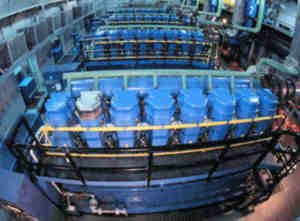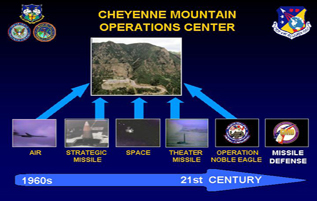Cheyenne Mountain Air Force Station, Colorado
Since the end of the Cold War, activities at Cheyenne Mountain have not diminished, but have in fact matched the evolving realities of the changing world. The original North American Air Defense Command (NORAD) Combat Operations Center (COC) has evolved into the Cheyenne Mountain Operations Center (CMOC), and is currently undergoing a transformation in to the Cheyenne Mountain Directorate (CMD) of NORAD-USNORTHCOM.
Today, the Cheyenne Mountain Complex is known as Cheyenne Mountain Air
Force Station (CMAFS). CMAFS is host to four commands: North American Aerospace
Defense Command (NORAD), United States Northern Command (USNORTHCOM), United
States Strategic Command (USSTRATCOM), and Air Force Space Command (AFSPC).
CMOC serves as the command center for both NORAD and USNORTHCOM. It is the
central collection and coordination center for a worldwide system of satellites,
radars, and sensors that provide early warning of any missile, air, or space
threat to North America.
Supporting the NORAD mission, CMD provides warning of ballistic missile or air attacks against North America, assists the air sovereignty mission for the U.S. and Canada, and if necessary, serves as the focal point for air defense operations to counter enemy bombers or cruise missiles. In addition, CMD also provides theater ballistic missile warning for U.S. and allied forces. In support of USSTRATCOM, CMD provides a day-to-day picture of precisely what is in space and where it is located. Space control operations include protection, prevention, and negation functions supported by the surveillance of space.
CMD is truly one of the most unique installations in the world. Apart from the fact that it is housed 2,000 feet underground, CMD is also different from most military units because it’s a joint and bi-national military organization comprised of over 200 professional men and women from the Army, Navy, Marine, Air Force, and Canadian Forces. Operations are conducted in seven centers manned 24 hours a day, 365 days a year. The centers are the Air Warning Center, Missile Correlation Center, Space Control Center, Operational Intelligence Watch, Systems Center, Weather Center, and the Command Center.
Performance CriteriaThe underground Combat Operations Center (COC) was designed to ensure 70 percent probability of continuing to function against a five megaton weapon with a three mile circular error probability (CEP), be self-sufficient for brief emergency periods, have backup communications and television intercom with related commands, limited, but adequate, sleeping facilities are available within the main Complex for use during button-up exercises or actual emergencies, and protection against fallout and biological and chemical warfare. The facility was ultimately designed to withstand a multi-megaton yield weapon at a range between 1 ? nautical miles.
Performance criteria changed as design and construction progressed to better provide for shock-mounting of the interior buildings and protect against electro-magnetic pulse (EMP). All connections between buildings and components were to be designed for the required flexibility to remain functional. Blast Doors to close and protect the complex from blast and overpressure were required. The initial design criteria was based on the stated assumptions concerning the yield and accuracy of future weapons and acceptable risks.
Design
The main entrance to the complex is approximately one-third of a mile from
the North Portal via a tunnel which leads to a pair of steel Blast Doors each
weighing 25 tons. Behind the 25-ton blast doors is a steel building complex
built within a 4.5 acre grid of excavated chambers and tunnels and surrounded
by 2,000 feet of granite. The main excavation consists of three chambers 45
feet wide, 60 feet high, and 588 feet long, intersected by four chambers 32
feet wide, 56 feet high and 335 feet long. Fifteen buildings, freestanding
without contact with the rock walls or roofs and joined by flexible vestibule
connections, make up the inner complex. Twelve of these buildings are three
stories tall; the others are one and two stories.
The outer shell of the buildings is made of three-eighths-inch continuously
welded low carbon steel plates which are supported by structural steel frames.
Metal walls and tunnels serve to attenuate electro-magnetic pulse (EMP).
Metal doors at each building entrance serve as fire doors to help contain
fire and smoke. Emphasis on the design of the structure is predicated on the
effects of nuclear weapons; however, building design also makes it possible
for the complex to absorb the shock of earthquakes.
Blast Valves, installed in reinforced concrete bulkheads, have been placed in the exhaust and air intake supply, as well as water, fuel, and sewer lines. Sensors at the North and South Portal entrances will detect overpressure waves from a nuclear explosion, causing the valves to close and protect the complex. All of the buildings in the complex are mounted on 1,319 steel springs, each weighing approximately 1,000 pounds. The springs allow the complex to move 12 inches in any one direction. To make the complex self-sufficient, adequate space in the complex is devoted to support functions. A dining facility, medical facility with dental office, pharmacy and a two-bed ward; two physical fitness centers with exercise equipment and sauna; a small base exchange, chapel, and barber shop are all located within the complex.
 Within the complex are all the utility systems necessary to make the facility
functional. The primary supply of electrical power is supplied by the City
of Colorado Springs. The secondary source or back-up power supply is provided
by six 1,750 kilowatt, 2,800 horse-powered diesel generators.
Within the complex are all the utility systems necessary to make the facility
functional. The primary supply of electrical power is supplied by the City
of Colorado Springs. The secondary source or back-up power supply is provided
by six 1,750 kilowatt, 2,800 horse-powered diesel generators.
Water for the complex comes from an underground water supply inside Cheyenne Mountain. Today, 30,000 to 120,000 gallons of water is deposited into four excavated reservoirs. Three of these reservoirs serve as industrial reservoirs and the remaining reservoir serves as the complex’s primary domestic water source. Each of the four reservoirs have the capacity to store 1.5 million gallons of water.
Incoming air may be filtered through a system of chemical/biological/radiological (CBR) filters to remove harmful germs and/or radioactive and chemical particles. The fresh air intake is mainly from the south portal access which is 17 ? feet high and 15 feet wide and linked to the north portal access which is 22 ? feet high and 29 feet wide. The entire tunnel from north to south entry portals is nine-tenths of a mile long.
EvolutionSince its inception, the mission in the Mountain has continually evolved to adapt to the changing world situation. Future planning and incorporating leading technology have allowed Cheyenne Mountain to cover threats ranging from the early Soviet manned bombers to today's short-range ballistic missiles that threaten our troops deployed overseas.
The original requirement for an operations center in Cheyenne Mountain was to provide command and control in support of the air defense mission against the Soviet manned bomber threat, but several events and emerging technologies drove this mission to evolve.
The launch of Sputnik, the world's first man-made satellite, on Oct. 4, 1957,
demonstrated not only the accomplishments of the Soviet’s space program,
but also the capability to launch nuclear warheads from one continent to another.
In the early 1960s, the advent of an Intercontinental Ballistic Missile (ICBM) attack against North America became a top priority. Missile warning and air sovereignty were the primary missions in the Mountain throughout the 1960s and 70s. During a brief period in the mid 1970s, the Ballistic Missile Defense Center was installed within the Mountain.
In 1979, the Air Force established a Space Defense Operations Center to counter the emerging Soviet’s anti-satellite threat. Although the space defense capabilities and systems established in Cheyenne Mountain were in their infancy, this marked the beginning of an increasing role in space.
The evolution continued into the 1980s when Air Force Space Command was created and tasked with the Air Force Space mission. In April 1981, Space Defense Operations Center crews and their worldwide sensors, under the direction of Air Defense Command, supported the first flight of the space shuttle. Cheyenne Mountain has continued to support every shuttle mission since.
In the latter part of the 1980s, the air sovereignty mission received renewed emphasis and continues to this day, to play a role in working with U.S. and Canadian Customs and Drug Enforcement Agencies. The Air Warning Center, through its air defense network, provides surveillance and control of air operations to North America.
In the early 1990s, Desert Storm created the need to provide Theater Ballistic Missile Warning (TBMW) for deployed forces. The use of Defense Support Program (DSP) Satellites, with its capability to detect heat from missile and booster plumes, provided warning to civilian populations and coalition forces in Israel and Saudi Arabia during the war.
The lessons learned during the Gulf War highlighted the importance of being able to provide timely TBMW to our deployed forces. Today, Cheyenne Mountain Directorate (CMD) has refined this process and is capable of detecting theater ballistic missiles and communicating those threats to the theater commander as soon as they emerge.
On Sept. 11, 2001, Cheyenne Mountain added another mission to its historic legacy in the defense of North America. The terrorist attacks against the United States marked the beginning of Operation Noble Eagle. Operation Noble Eagle is a homeland defense mission incorporating NORAD's mission of Aerospace Warning and Control to include the monitoring of the interior airspace of Canada and the United States. Today, NORAD and CMD stand ready to assist the Federal Aviation Administration and Navigation Canada in responding to any threatening or hostile domestic aircraft.
Oct. 1, 2002 marked the welcoming of two new commands, U.S. Northern Command and U.S. Strategic Command, to Cheyenne Mountain. CMD is responsible for providing support to USNORTHCOM's mission of homeland defense and USSTRATCOM's mission of space and missile warning, formerly associated with U.S. Space Command.